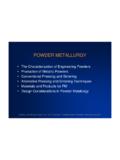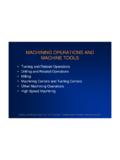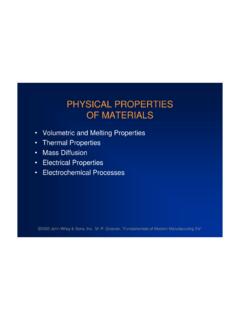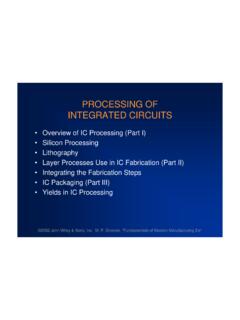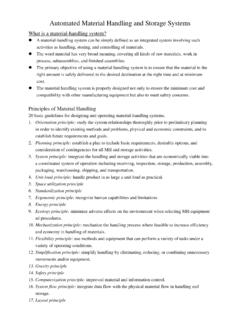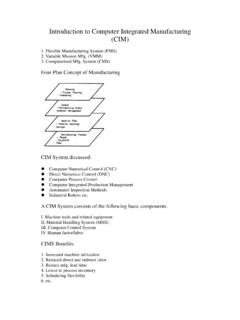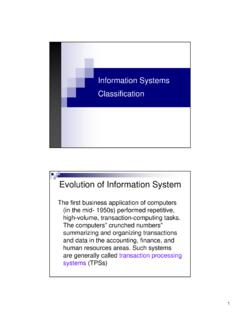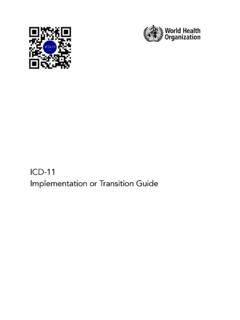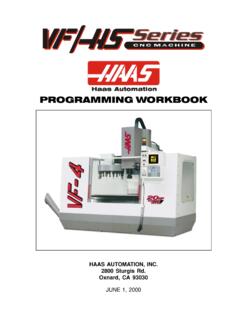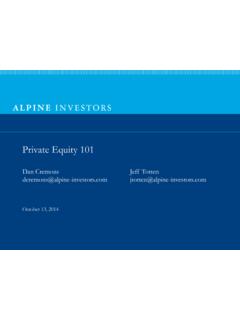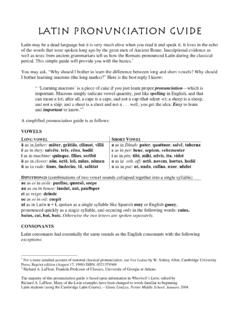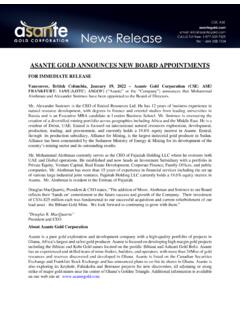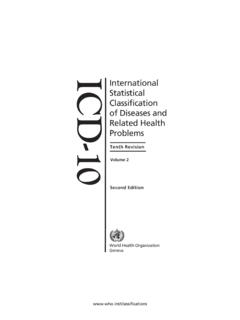Transcription of Production and Operations Management - POM
1 Production and Operations Management - POM POM should teach to understand manufacturing technology and its role in developing business strategy. When managers do not understand technology, they tend not to invest in emerging technologies. Would you bet a billion dollars on something you don t understand? Functions or departments in business Three primary functions: Production : without Production , no products or services could be produced. Marketing: without marketing, no products or services could be sold. Finance: without finance, financial failure would surly result. Production managers A Production system takes inputs raw material, personnel, machines, buildings, technology, cash, and other resources and converts them into outputs products and services.
2 This conversion process is the heart of what is called Production and is the predominant activity of a Production system. Operations managers manage the Production system; their primary concern is with the activities of the conversion process or Production . Marketing mangers Managers in the marketing function are responsible for creating a demand for an organization s products and services. This responsibility entails activities such as identifying prospective customers, advertising and promoting products and services, storing, displaying and demonstrating products and services, supervising salespersons, setting sales prices, receiving revenues, and providing an interface with customer. Managers in the finance Managers in the finance responsible for achieving the financial objectives of the firm.
3 This responsibility entails activities such as providing liquidity, providing financial-performance information to other managers, preparing financial information for stockholders, establishing lines of credit, etc. Operations , marketing, and financial managers have much in common They develop plans for the future, they design organization structured, and they mange employees. In managing employees, they hire, train, supervise, measure, motivate, and lead employees; they build teams and set goals. Business cannot succeed without Production , marketing, or finance. Whereas Production , marketing, and finance act independently to achieve their individual function goals, they act together to achieve the organization s goals. Although, managers in Production , marketing, and finance have much in common, the decision that they make can be distinctly different.
4 The Evolution of POM 1. The Industrial Revolution - In England in the 1700s, this advancement involved two principal elements: the widespread substitution of machine power for human power and the establishment of the factory system. 2. Post-Civil War Period - the beginning of modern forms of capital through the establishment of joint stock companies. This development led to the eventual separation of the capitalist from the employer, with managers becoming salaried employees of the financiers who owned the capital. 3. Scientific Management - contributions: time study, methods analysis, motion study, human factor in work, Gantt charts - getting the desired result with the least waste of time, effort, or materials. 4.
5 Human Relations and Behaviorism - The human relations movement studies were initially begun by industrial engineers and were aimed at determining the optimal level of lighting to get the most Production from work. When these studies produced confusing results about the relationship between physical environment and worker efficiency, the researchers realized that human factors must have been affecting Production . This is the first time that psychological and sociological factors affected not only human motivation and attitude but Production as well was recognized. 5. Operations Research - In World War II enormous quantities of manpower, supplier, planes, ships, materials, and other resources had to be deployed in an extremely hectic environment.
6 The concepts of a total systems approach and of interdisciplinary teams and the utilization of complex mathematical techniques had been used in solving the industrial complex problems. Operations research, seeks to replace intuitive decision making for large complex problems with an approach that identifies the optimal, or best, alternative through analysis. 6. The Service Revolution The creation of service organizations accelerated sharply after World War II and is still expanding toady. More than two-thirds of the work force is employed in services, roughly tow-thirds of the gross national product (GNP) is produced by services, and investment per office worker now exceeds the investment per factory worker. 7. Today s Developments Factors Affecting POM Today 1.
7 Global competition - the rapid expansion of worldwide communication and transportation systems, the conversion of Eastern European countries to free-market economies, the EC Market and free trade. 2. Productivity, Cost, and Quality Challenges - these are so fundamental in global competition that basic changes may need to be made in manufacturing and service Operations . 3. Computers and High-Tech Production Technology Evolving Uses of Computers in POM 1950s Clerical duties - Payrolls, billings, inventory transactions, cost reports. 1960s Analysis of Operations - Linear programming, scheduling, planning and control. 1970s Mfg planning and control systems - Information systems for Mfg that integrate forecasting, inventory planning, MRP, scheduling, and shop floor control.
8 1980s CIM - Robots, engineering design terminals, FMS, AS/RS, CAD/CAM. 1990s Decision support systems (DSS), expert systems, and AI - these systems may provide computational support or imitate decision makers' through processes. 2000s Internet communication, B2B, financial business. What else? 4. Issues of Social Responsibility Three ways of studying POM 1. Production as a System Concept: - Production system: A system whose function is to convert a set of inputs into a set of desired outputs. - Conversion subsystem: A subsystem of the larger Production system in which inputs are converted into outputs. - Control subsystem: A portion of the outputs is monitored for feedback signals to provide corrective action if required. 2.
9 Production as an Organization Function - The process of conversion is at the heart of Production and Operations Management and is present in some form in all organizations. Where this conversion process is carried out and what we call the department or function where it is located vary greatly among organizations. 3. Decision Making in POM - The best way to understand how Operations managers manage the examination of the decisions in POM, these include: Strategic decisions: Decisions about products, processes, and facilities. (long-term) (launch a new-product development, design for a Production process, allocate scarce raw materials, utilities, Production capacity, new factories need) Operating decisions: Decisions about planning Production to meet demand.
10 (how much finished-goods inventory to carry, what products and how muck of next period, whether to increase by overtime or subcontract to suppliers) Control decisions: Decisions about planning and controlling Operations .(short term) Design and Development 1. The search for something new: Solo search: more frequently, ideas are sought for relatively minor modifications and improvements: a way to make an operation safer or a change in data flow that saves time. Group ideation: verbalization is formalized by techniques as brainstorming and synergism: The sum of the ideas from a group of people operating together should exceed the total number of ideas that the same people could generate operating individually. 2. Cause-And-Effect (C&E) Analysis - The value of visual aids in understanding a problem is tremendous.
